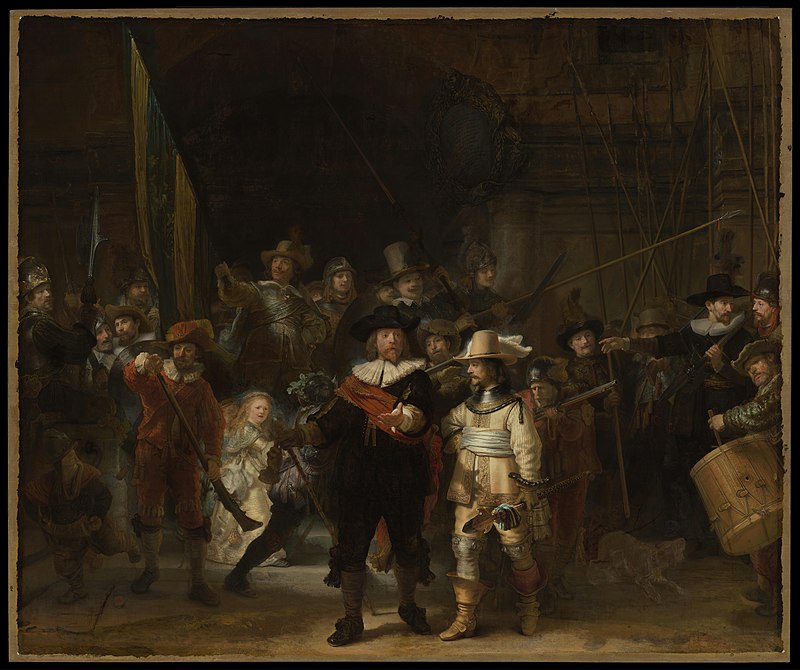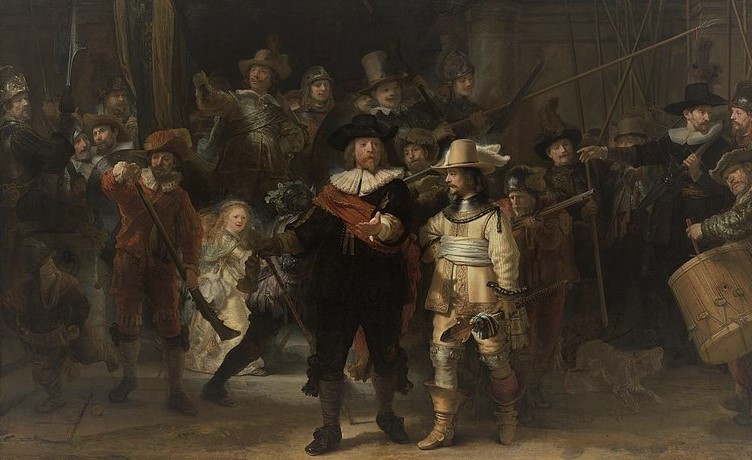Do you think the visual representation of power hides in paintings or Artworks? Power is an inevitable element of human culture; as Foucault claims, ”individuals are the product of power”. A painting, ‘The night watch’, was completed in 1642 by the Dutch golden age master Rembrandt (1606- 1669), evidently narrates the visual representation of power in the name of the Army movement and Army camps.
A wealthy landlord and a military person named Captain Banning Cocq and his army people commissioned this painting in 1639. Captain maintained a central figure in the picture, and seventeen members of his military groups also appeared. In the painting situation, the captain orders the Army to move out. They are starting to move from there according to the captain’s order. Army’s caption order is visually visible in this painting, and that action is echoed subtly in this narration.
According to Foucault, the soldier was recognized from afar because of his signs. This painting exhibits a military man’s natural strength, courage, and pride. The way the captain maintains his power in the central position of the composition is just a replica of the events that occurred in a particular time and space. This work was commissioned by military people depicted in hierarchical order in this painting; they are articulating or playing as a sign of exercise of power. German art critic Alois Riegl wrote about this painting. He mainly focused on the subordination of people and the captain’s gaze. People are subordinate to the central figure of this composition in different ways, and the way they look and see the present situation is also prominent. Everyone’s gaze is coordinated and controlled by the central figure, which becomes a source of looking and seeing. Alois Riegl writes about subordination and bodily actions and how they become an expression of will. What we are experiencing here as a painting is a constructed ideal form of looking and acting.
According to Foucault, the classical age discovered the body as an object and target of power. It is easy enough to find signs of the attention then paid to the body — to the body that is manipulated, shaped, trained, obeys, responds, becomes skilful and increases its forces.” (Foucault, 1995, p. 136). Foucault talks about docile bodies and how the classical age used body language and controlled it. In this painting, what do we see? A composition of docile bodies controlled by the powerful man’s commands. According to Foucault, the body was under rigorous powers, which imposed its constraints, prohibitions or obligations. The exhibition of power in visual representation happens like a well-composed portrait.

Then Foucault talks about the object of control, the modality of the operations supervising the activity process. This gesture in the painting is a highly controlled movement and action. The artist displayed this event in a unique style and composition. What Alois Riegl (1858–1905) claims in his text about subordination is visible in the painting. Army men are portrayed in a specific order, and with the brilliant use of light and darkness, all compositions represent the exercise of power.
How is this method, the control of the body, established or made possible? Foucault argues about meticulous control of the body’s operations, forcefully subordinated by a powerful structure like the Army. According to Foucault, here we see this image as an expression of obedience forcefully imposed on them, called ‘discipline’. The military is central to implementing disciplinary methods in different styles and forms. The military men are ready to receive the captain’s order—obedience to bodily actions is significant.
According to Foucault, 17th and 18th-century disciplinary actions transformed into a general domination formula. Then this painting from the middle of the 17th century will be considered a visual representation of this phenomenon.
Foucault writes: ‘The historical moment of the disciplines was the moment when an art of the human body was born, which was directed not only at the growth of its skills, nor at the intensification of its subjection, but at the formation of a relation that in the mechanism itself makes it more obedient as it becomes more useful, and conversely’ (p 137–138). Can we consider this a portrait of when the discipline was born? And the narration of how the art of the human body language was formulated and controlled? Can we assume that Foucault frequently mentions the mechanism in his text, the Army, which constructed a flagship model of the exercise of power according to this painting?
Foucault writes, ‘The human body was entering a machinery of power that explores it, breaks it down and rearrange it”. Here, we see a rearranged format of moments according to the army norms and rules. Their vigilance, and the way they respond to the master’s call, are visually appealing. The artist took sketches for the painting and did it in three years. The entire Army, including the captain, may perform this event for artists to draw, like a ritual or repeating patterns. Artists commissioned for the whole of the army group, not only for the captain. But the captain gets a prominent seat and perfect light in this composition. Others are narrated as obedience to the authority of power.
The source of power comes to the centre; these events, including the completion of the painting, happen inside the world of power. The artist commissioned by the army group gets paid for work. Then, I assume that the artist deliberately narrates the ambience of authority and obedience, not just portrays them. The artist may convey what he experiences in moments and what is happening in the surrounding world in the Army’s name. The brutality of the Army’s power wasn’t narrated in Rembrandt’s painting but in power.
This painting is a powerful representation of the exercise of power in 17th-century Europe. What is narrated on the canvas, the process, and how the artwork is commissioned are also significant.
Feature Image: The night watch- detail (1642) by Rembrandt | Credit: Wiki

Krispin Joseph PX, a poet and journalist, completed an MFA in art history and visual studies at the University of Hyderabad.






